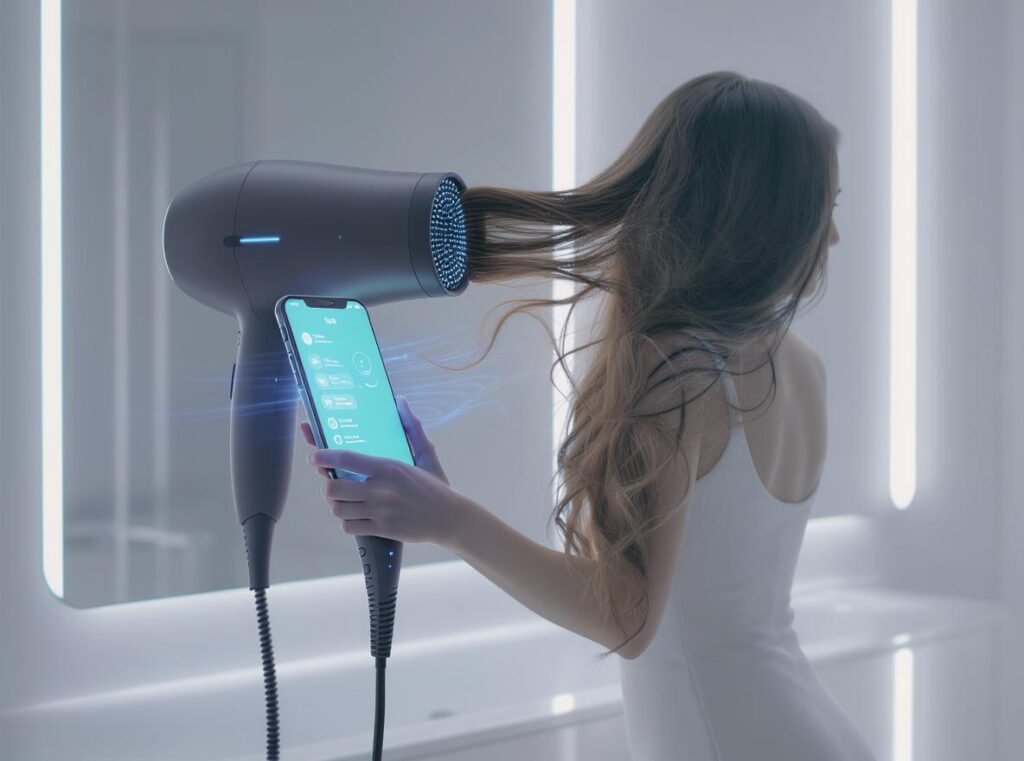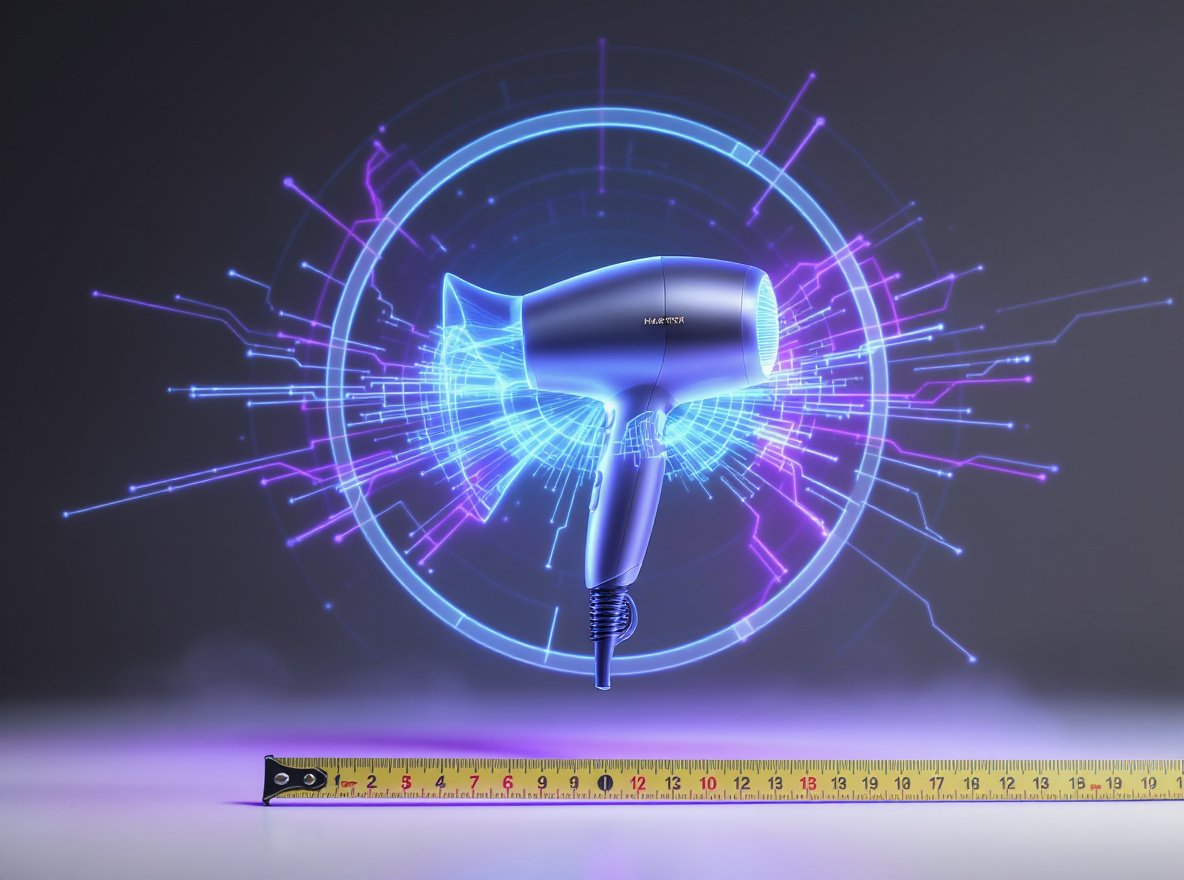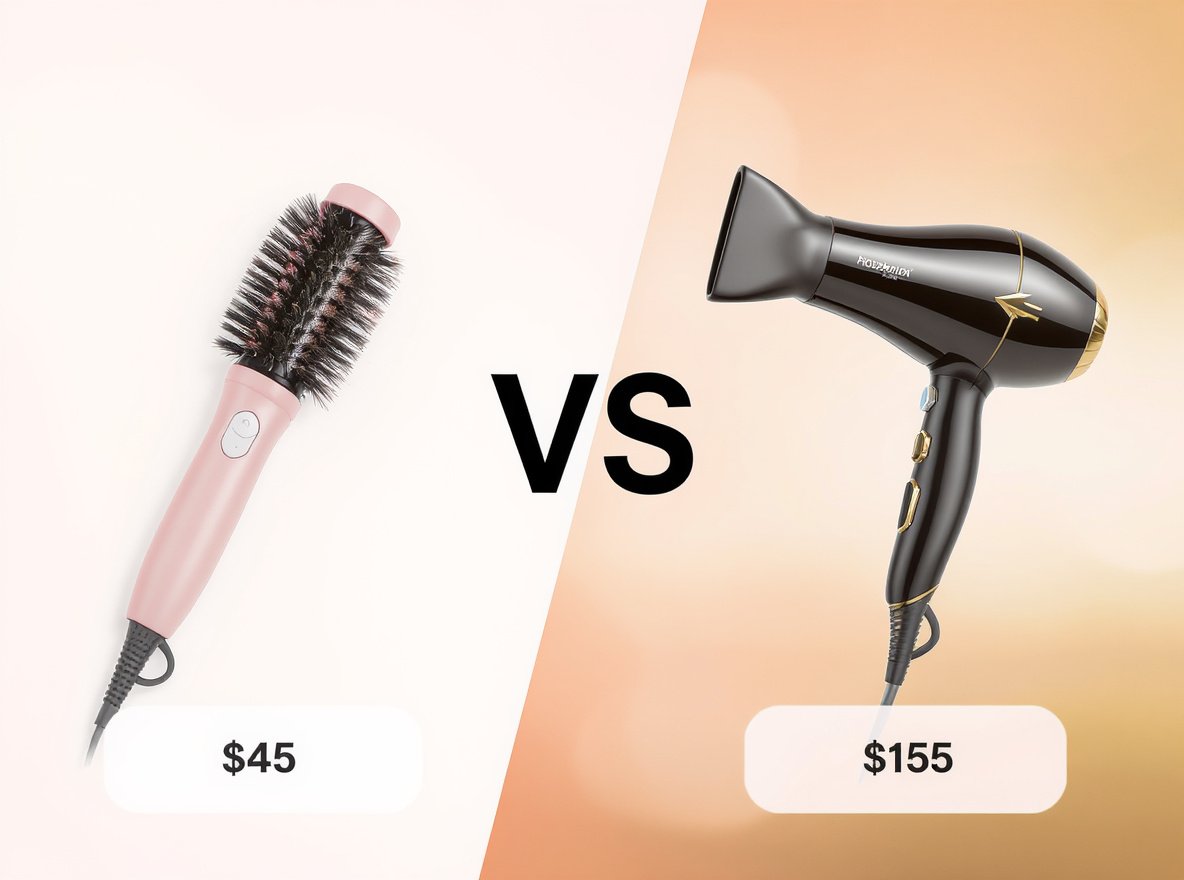Smart hair dryers with app connectivity promise personalized styling and automated settings, but do they actually deliver better results? Many consumers wonder if these high-tech features justify the premium price compared to traditional models.
Smart hair dryers with apps do work better for most users because they offer personalized heat and airflow adjustments, prevent heat damage through sensor technology, and provide customized styling modes. Performance improvements include up to 75% faster drying times and consistent salon-quality results at home.
Let’s explore everything you need to know about smart hair dryers to help you decide if they’re worth the investment.
Table of Contents
ToggleWhat Are Smart Hair Dryers and How Do They Work?
Understanding smart hair dryer technology is crucial before deciding if they’re right for your business or personal use.
Smart hair dryers are advanced styling tools equipped with sensors, Bluetooth or Wi-Fi connectivity, and sometimes artificial intelligence that measure hair moisture and temperature in real-time, automatically adjusting heat and airflow to optimize drying while preventing damage.
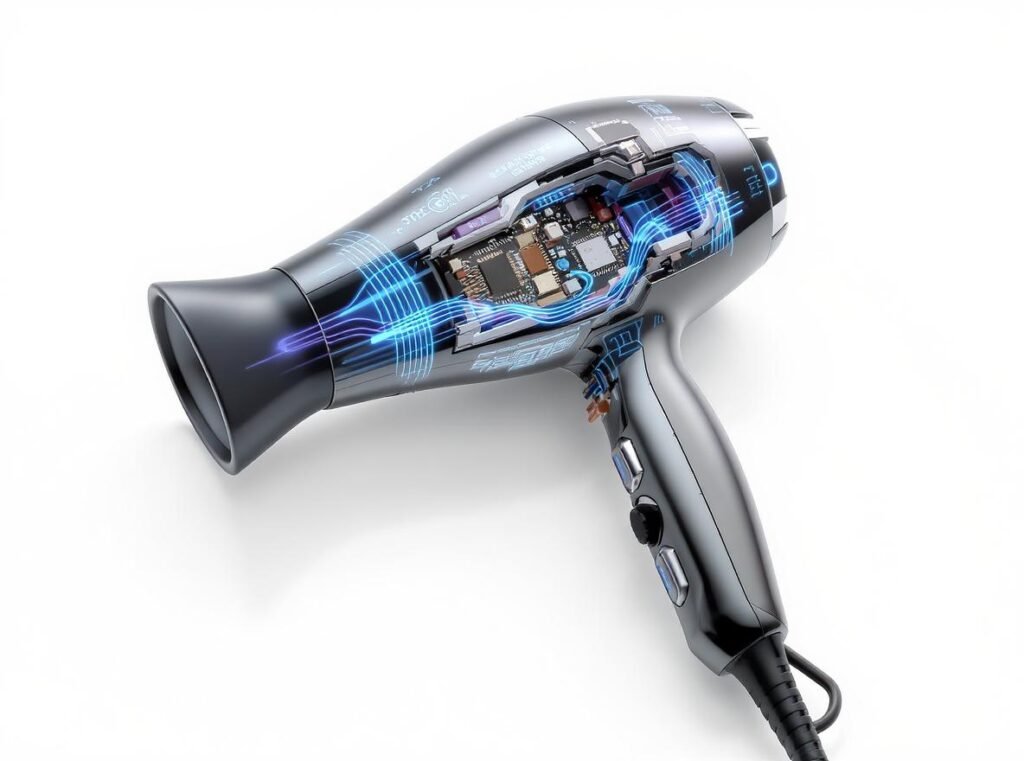
Smart hair dryers use embedded sensors including humidity, distance, and temperature monitors to track your hair and scalp condition during use. The device’s microprocessor or AI then dynamically adjusts heat and airflow to optimize drying performance.
Key technological components include:
- Real-time monitoring sensors that measure hair moisture and temperature continuously
- Automatic adjustment systems that modify heat and airflow based on hair condition
- Memory storage for user preferences and styling routines
- App-based controls for personalized settings and custom modes
- Voice assistant integration for hands-free operation
The technology works by continuously analyzing your hair’s condition and environmental factors. When sensors detect optimal moisture levels, the dryer automatically reduces heat to prevent over-drying. This intelligent feedback system maintains your hair’s natural moisture balance while achieving desired styling results.
Unlike traditional dryers that operate at fixed settings, smart models adapt in real-time to deliver consistent performance regardless of hair type, thickness, or environmental conditions.
Do Smart Hair Dryers with Apps Really Work Better?
Performance improvements from smart hair dryers extend beyond basic convenience features to measurable styling benefits.
Yes, smart hair dryers with apps work significantly better than traditional models, delivering up to 75% faster drying times, consistent salon-quality results, and convenient features that adapt to individual hair needs and family members’ preferences.
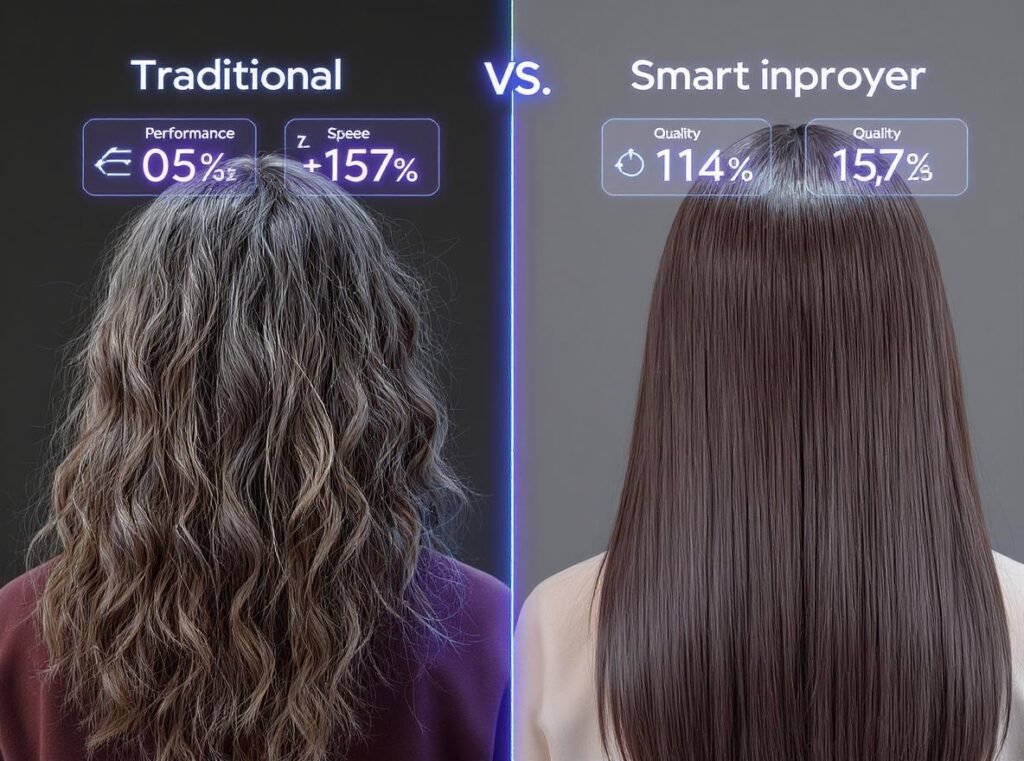
Performance advantages include:
Faster Drying Speed: High-speed motors combined with intelligent airflow optimization cut drying time by up to 75% compared to traditional models. The smart sensors ensure maximum efficiency without compromising hair health.
Consistent Results: Automatic adjustments prevent over-drying, reduce frizz, and improve shine. Users report achieving salon-quality results at home, especially beneficial for those who regularly style their hair or have specific hair care needs.
Convenience Features: App functionality allows users to pre-set modes for different hair types, family members, or even pets, recalling them instantly. This eliminates guesswork and ensures optimal results every time.
| Performance Metric | Smart Hair Dryer | Traditional Dryer |
|---|---|---|
| Drying Speed | Up to 75% faster | Standard |
| Heat Control | Automatic adjustment | Manual only |
| Consistency | AI-optimized | User-dependent |
| Customization | Multiple presets | Limited settings |
Independent testing and user feedback consistently show that smart dryers deliver superior results, particularly for complex hair types and professional styling applications.
Do Smart Hair Dryers Actually Prevent Heat Damage?
Heat damage prevention is one of the most significant advantages of smart hair dryer technology, addressing a primary concern for frequent users.
Yes, smart hair dryers are specifically designed to minimize heat damage through real-time temperature control, moisture sensors, and advanced materials that keep heat output within safe limits of 50-55°C, significantly reducing the risk of burning hair or scalp.
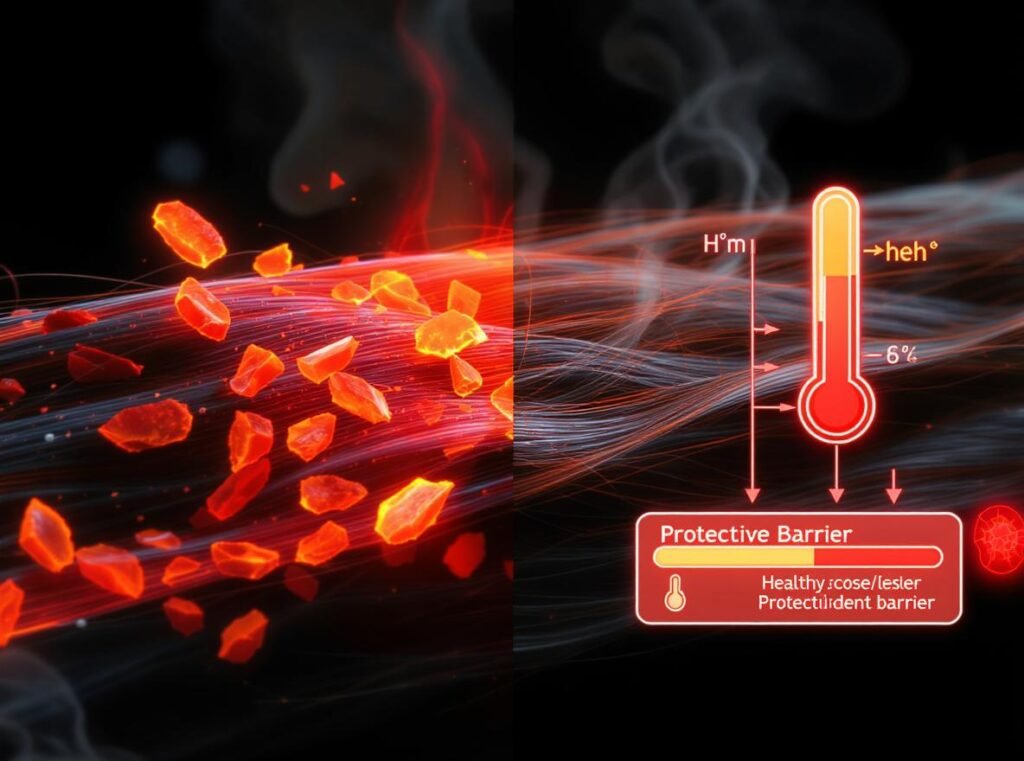
Heat damage prevention works through multiple mechanisms:
Real-time Temperature Control: Advanced sensors monitor and regulate heat output continuously, maintaining safe temperature ranges that protect hair structure. This prevents the excessive heat that causes protein damage and moisture loss.
Moisture Detection Technology: Sensors detect remaining moisture levels and automatically lower heat as hair dries, preventing over-drying and brittleness. This ensures optimal moisture retention while achieving complete drying.
Ionic and Ceramic Technology: These materials produce negative ions that reduce frizz while delivering even, gentle heat distribution. The combination eliminates hot spots that can cause localized damage.
The technology is particularly effective for:
- Chemically treated hair that’s more vulnerable to heat damage
- Color-treated hair where excessive heat can cause fading
- Fine hair that requires gentler treatment
- Damaged hair that needs protective styling
Studies show that consistent use of smart dryers with proper heat management can actually improve hair health over time by reducing cumulative heat damage.
What App Features Make Smart Hair Dryers Worth It?
App functionality transforms smart hair dryers from simple styling tools into personalized hair care systems.
The most valuable app features include custom mode programming for different users and styling needs, usage tracking for optimization, maintenance alerts for device longevity, and voice control integration for hands-free operation.
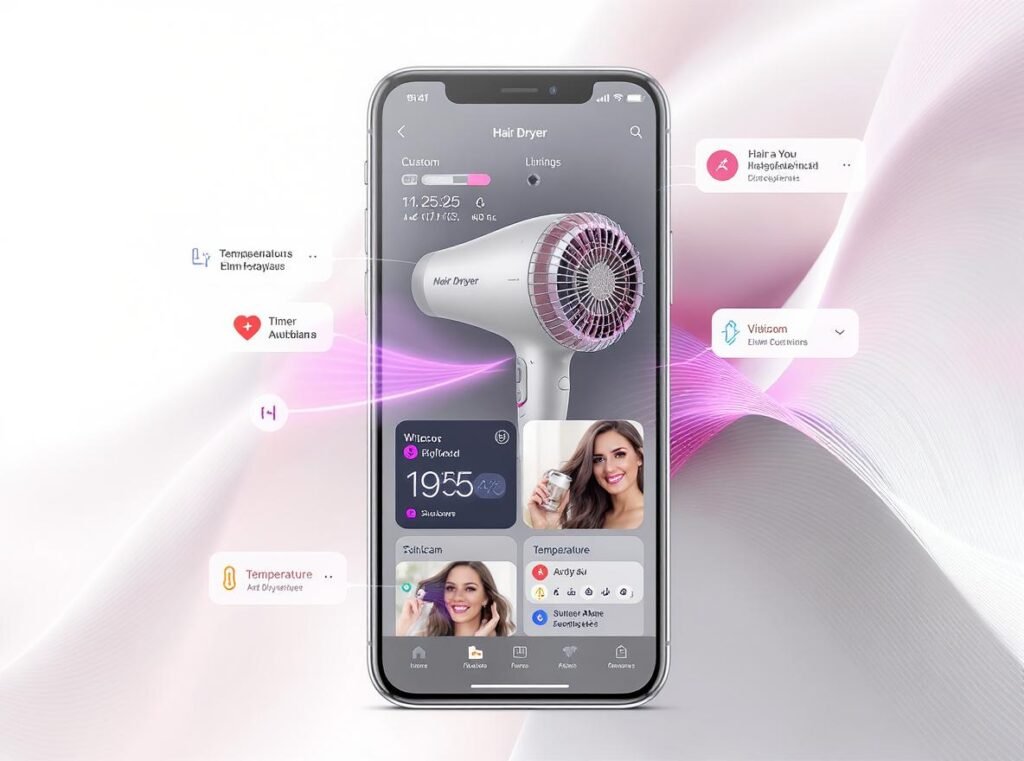
Essential app features that add real value:
Custom Mode Programming: Save and recall personalized settings for different users or styling needs such as “Kids Mode,” “Quick Dry,” or “Styling Mode.” This ensures optimal results for each family member’s unique hair type and preferences.
Usage Tracking and Analytics: Monitor drying time, temperature preferences, and energy consumption patterns. This data helps users optimize their routine and identify the most effective settings for their hair type.
Maintenance Alerts: Receive timely reminders for cleaning filters, servicing components, or replacing parts. This proactive approach extends device life and maintains optimal performance.
Voice Control Integration: Smart home assistant compatibility allows hands-free operation, particularly useful during busy mornings or when hands are occupied with styling tools.
Firmware Updates: Receive new features, performance improvements, and bug fixes over time, ensuring your investment remains current with technological advances.
Tutorial Integration: Access styling tutorials, product recommendations, and technique guides directly through the app, helping users maximize their investment.
Are Smart Hair Dryers Better for Different Hair Types?
Smart dryers excel at adapting to various hair textures and conditions, providing customized care that traditional dryers cannot match.
Smart hair dryers are superior for all hair types but provide exceptional benefits for curly, thick, fine, and frizzy hair through adaptive technology that adjusts heat and airflow based on specific hair characteristics and sensitivity levels.
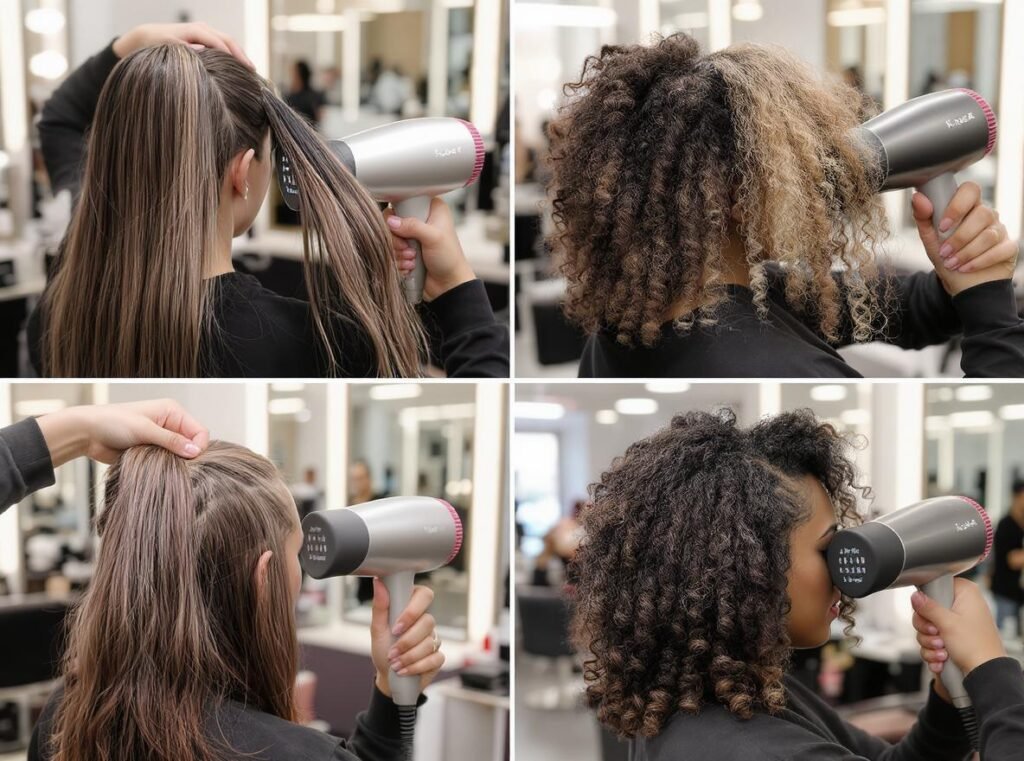
Hair type-specific benefits:
Fine Hair: Lower heat settings and gentle airflow prevent breakage while maintaining volume. Smart sensors detect fine hair’s delicate structure and adjust accordingly to prevent damage and static.
Thick or Curly Hair: High-speed airflow and specialized diffusers dry hair quickly without causing frizz or flattening natural curl patterns. The technology preserves curl definition while reducing drying time.
Frizzy Hair: Ionic technology helps smooth hair cuticles and add shine. Temperature control prevents the excessive heat that often exacerbates frizz in humid conditions.
Sensitive Scalps: Temperature sensors avoid overheating and irritation, making the styling process comfortable for those with scalp sensitivity or conditions like dermatitis.
Color-Treated Hair: Controlled heat exposure prevents color fading and maintains vibrancy. The gentle approach helps preserve chemical treatments and extends color life.
Damaged Hair: Protective settings help repair damaged cuticles over time while preventing further damage. The consistent, controlled heat promotes healthier hair structure.
What’s the Real Cost-Benefit Analysis of Smart Hair Dryers?
Understanding the true value proposition helps determine if smart dryers make financial sense for different user types.
Smart hair dryers cost $200-$500+ compared to $50-$300+ for traditional high-end models, but offer superior convenience, customization, and hair protection that can justify the premium for frequent users and professionals.
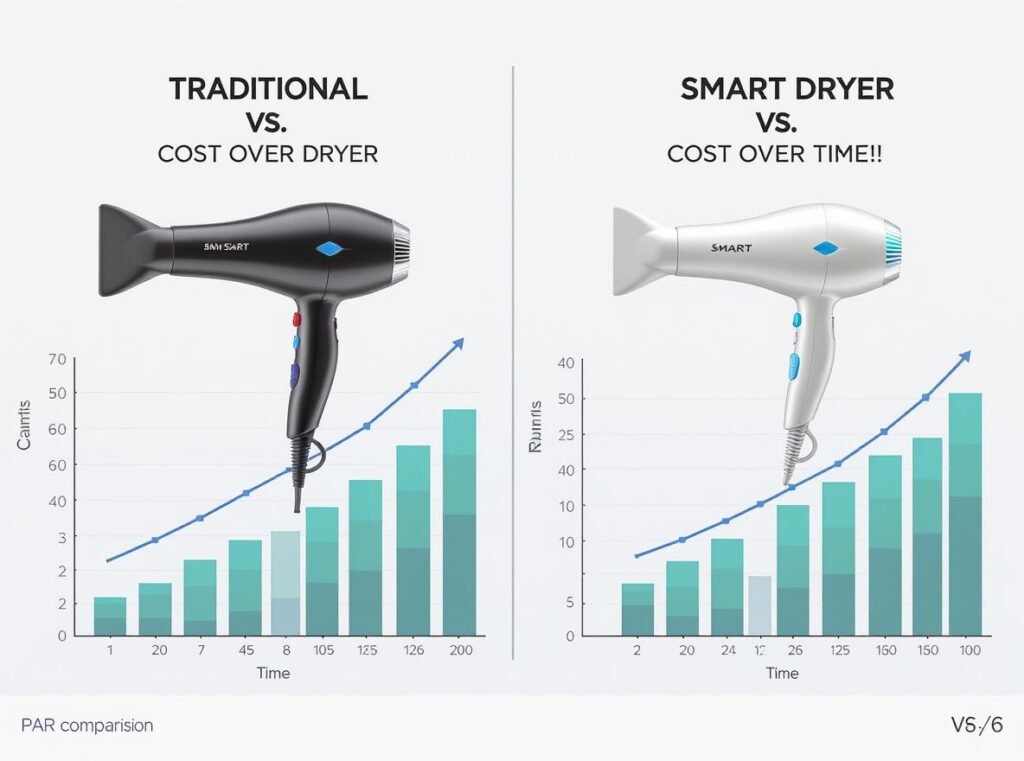
Comprehensive cost comparison:
| Aspect | Smart Hair Dryer | Traditional High-End Dryer |
|---|---|---|
| Initial Price | $200-$500+ | $50-$300+ |
| Drying Speed | Up to 75% faster | Moderate to fast |
| Heat Damage Prevention | Advanced sensors, AI control | Manual adjustment, basic tech |
| Customization | App, memory, presets | Manual settings only |
| Maintenance | Self-cleaning, app alerts | Manual cleaning required |
| Energy Efficiency | Optimized, eco-modes | Standard consumption |
| Longevity | Comparable (brand-dependent) | Comparable |
Long-term Value Factors:
Smart dryers often provide better value through reduced salon visits, fewer hair treatments needed for damage repair, and extended time between haircuts due to healthier hair. Many users report annual savings of $300-$500 on professional hair care.
Professional Benefits: For salon owners, faster service times mean more clients served, while consistent results improve customer satisfaction and justify premium pricing.
How Do Smart Hair Dryers Compare to Traditional High-End Models?
Direct comparison helps clarify when smart technology provides meaningful advantages over proven traditional designs.
Smart hair dryers offer superior speed, automatic control, and damage prevention compared to traditional high-end models, but traditional dryers may provide more raw power and simpler operation for users who prefer manual control.
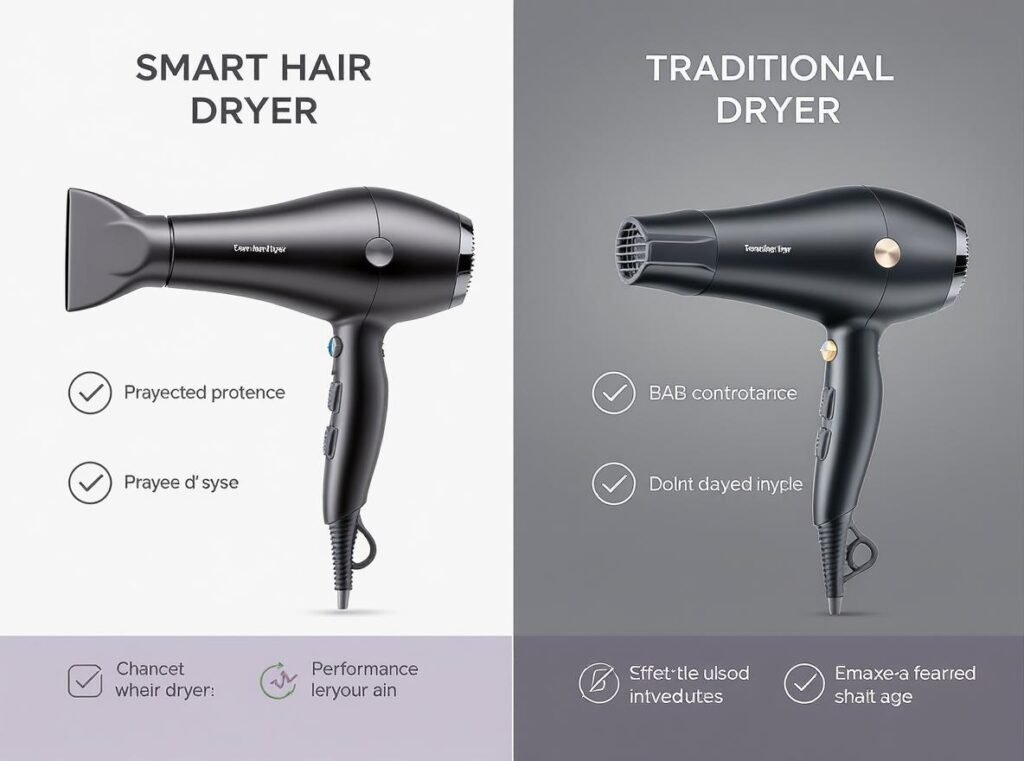
Performance comparison:
Speed and Efficiency: Smart dryers are generally faster due to high-speed motors and optimized airflow patterns. The intelligent systems maximize efficiency while traditional models rely on fixed settings.
Control Systems: Smart dryers offer automatic, real-time adjustments versus manual settings. This provides consistent results but may feel less intuitive to users accustomed to traditional controls.
Damage Prevention: More effective at protecting hair from heat through sensor technology and automatic adjustments. Traditional dryers require user expertise to prevent damage.
Noise Levels: Many smart dryers operate more quietly despite powerful motors, beneficial for home and salon environments. Traditional high-end models may be louder but some users prefer the audible feedback.
Maintenance Features: Self-cleaning cycles and app alerts prolong device life and maintain optimal performance. Traditional models require manual maintenance monitoring.
The choice often depends on user preference for automation versus manual control, with smart dryers excelling in convenience and consistency while traditional models offer simplicity and immediate responsiveness.
What Are the Potential Drawbacks of Smart Hair Dryers?
No technology is perfect, and smart dryers have limitations that potential buyers should consider before making an investment.
The main drawbacks include significantly higher upfront costs, potential technical complexity, dependency on app functionality, and possible connectivity issues that may frustrate users who prefer straightforward operation.
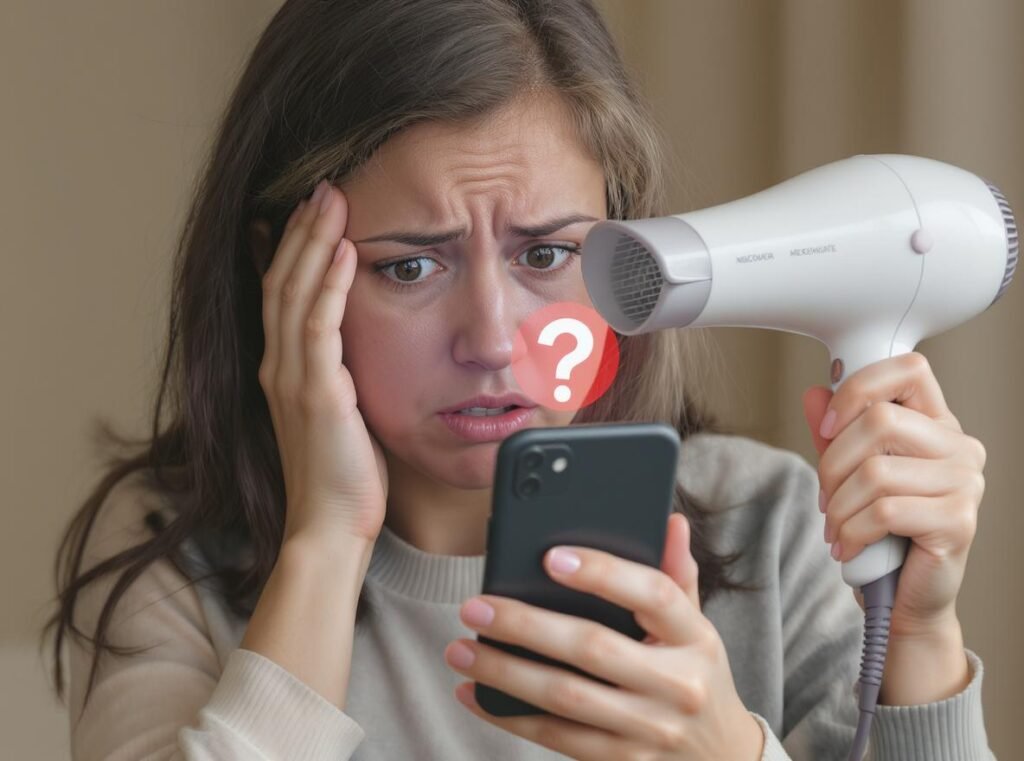
Common limitations include:
Cost Considerations: Significantly higher upfront investment that may not be justified for occasional users or those with simple hair care needs. The premium pricing can be prohibitive for budget-conscious consumers.
Technical Complexity: App setup and connectivity requirements may be unnecessary or frustrating for some users. The learning curve can be steep for those uncomfortable with technology.
Potential Technical Issues: Sensors or app connectivity can malfunction, potentially leaving users without access to preferred settings. Software updates may introduce bugs or change functionality.
Weight and Size: Added technology can increase device weight, though many models are designed to be lightweight. Some users find the additional bulk uncomfortable during extended use.
Noise Levels: Some models with high-speed motors may be louder than expected, though this varies significantly between brands and models.
App Dependency: Loss of phone connectivity or app crashes can limit functionality, though most models retain basic operation without app access.
Are Smart Hair Dryers Worth It for Professional Use?
Professional stylists and salon owners have different requirements that make smart dryers particularly valuable in commercial environments.
Smart hair dryers are excellent for professional use because they provide faster service times, consistent results across different stylists, improved client experience, and durability features designed for heavy commercial use.
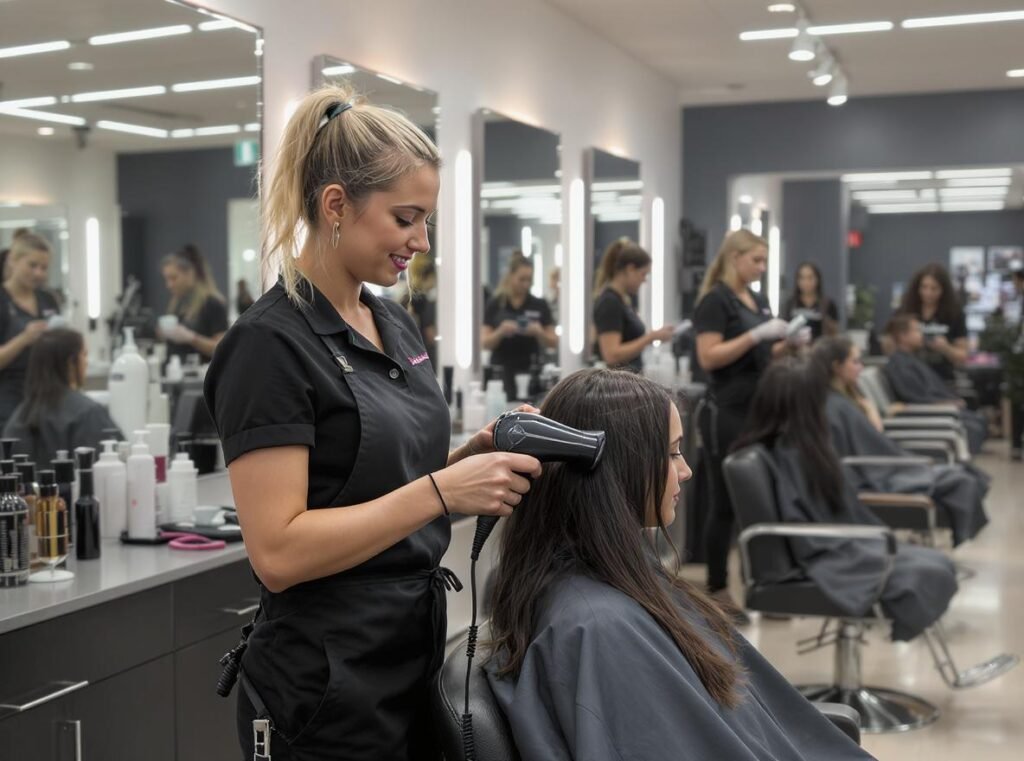
Professional advantages include:
Faster Service Delivery: Quicker drying times mean more clients can be served per day, directly increasing revenue potential. Time savings of 25-75% per client add up significantly in busy salons.
Consistent Results: Preset modes ensure repeatable, high-quality outcomes regardless of stylist experience level. This reduces training time and maintains quality standards across staff.
Durability Features: Professional models feature washable filters, longer cords, and robust construction designed for heavy use. Commercial-grade components extend lifespan in demanding environments.
Client Experience: Lower noise levels and personalized settings improve client comfort and satisfaction. The technology-forward approach appeals to modern consumers and can justify premium pricing.
Maintenance Benefits: Self-cleaning features and maintenance alerts reduce downtime and extend equipment life. This is particularly valuable in high-volume environments where equipment failure is costly.
Staff Training: Automated features reduce the skill gap between experienced and novice stylists, improving overall service quality and reducing training costs.
Should You Choose a Smart Hair Dryer or Traditional Model?
The decision depends on individual needs, hair type, styling frequency, and budget considerations.
Choose a smart hair dryer if you want maximum hair protection, have specific hair care needs, value convenience and speed, or are a professional user. Choose a traditional model if you prefer simple controls, have a limited budget, or rarely style your hair.

Decision framework:
Choose Smart Hair Dryer If:
- You have curly, frizzy, or sensitive hair requiring specialized care
- You style your hair frequently or professionally
- You value the latest technology and maximum hair protection
- You want convenience features and customization options
- You’re willing to invest in long-term hair health
Choose Traditional Model If:
- You have a limited budget or straightforward hair care needs
- You prefer simple, manual controls without app complexity
- You rarely style your hair or have basic drying requirements
- You’re comfortable with standard heat and speed settings
Professional Considerations: Salons should consider client demographics, service pricing, and staff technical comfort when making equipment decisions.
What Should Wholesalers Know About Smart Hair Dryer Market Trends?
Understanding market dynamics helps wholesalers, distributors, and retailers make informed inventory and pricing decisions.
The smart hair dryer market is experiencing rapid growth with expanding demand driven by consumer interest in personalization, hair health, and connected beauty devices, creating opportunities for premium positioning and diverse target audiences.

Key market insights:
Growing Market Demand: The market for smart, connected beauty devices is expanding rapidly, driven by increasing consumer awareness of hair health and technology integration in personal care.
Premium Market Positioning: Smart dryers occupy the higher end of the market, appealing to both tech-savvy consumers and professionals willing to pay for advanced features and better results.
Innovation Focus: Key differentiators include AI integration, app connectivity, eco-friendly operation, and personalization features. Brands are rapidly innovating to stay competitive.
Target Audience Diversity: Both home users and professional salons represent significant market segments, with different needs and purchasing patterns.
Competitive Landscape: Brands are rapidly innovating with new features and models, making it crucial for wholesalers to stay updated on technological developments and consumer preferences.
Seasonal Patterns: Holiday seasons and back-to-school periods show increased demand for tech-forward styling tools, helping with inventory planning.
For distributors considering smart dryers, the Conason P1C high-speed hair dryer offers advanced features at competitive wholesale prices. Our product incorporates many smart technologies while maintaining affordability for diverse market segments.
Summary
Smart hair dryers with app connectivity do work better than traditional models, offering measurable benefits including up to 75% faster drying times, superior heat damage prevention, and personalized styling options. While they require a higher initial investment ($200-$500+), the advanced features, convenience, and hair protection capabilities justify the premium for frequent users and professionals. The technology excels with all hair types but provides exceptional value for curly, thick, damaged, or color-treated hair that requires specialized care.
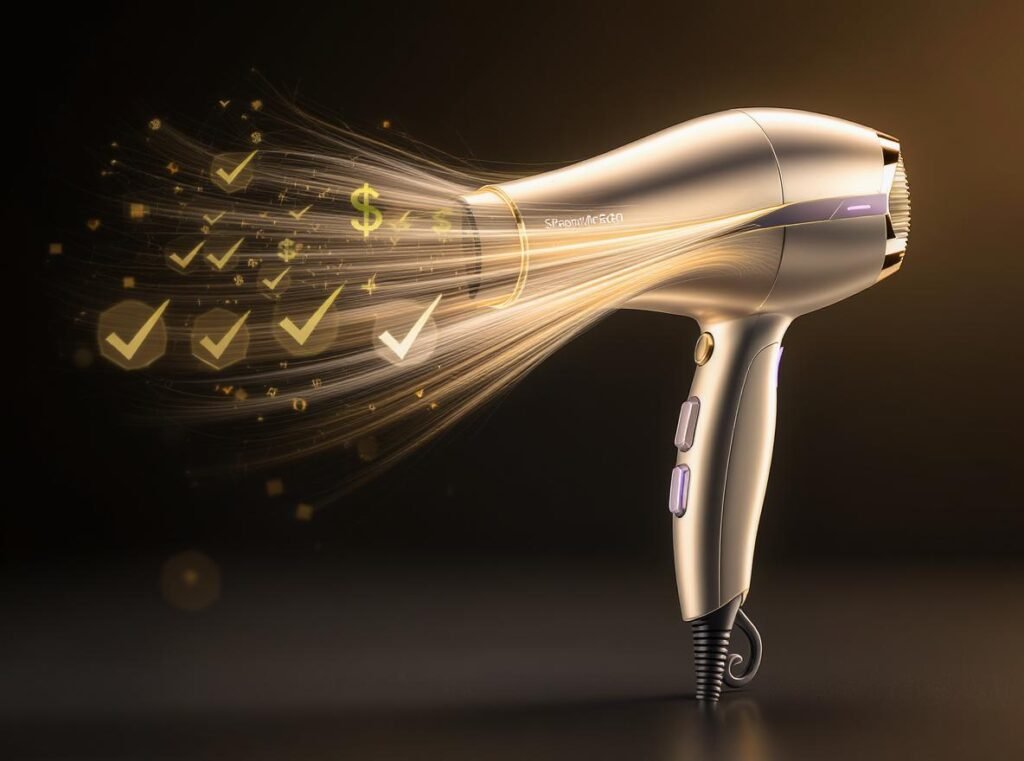
Ready to explore smart hair dryer options for your business? Visit our product collection page to discover the Conason P1C high-speed hair dryer and other professional-grade styling tools, or contact us to learn about wholesale opportunities that can help you meet growing consumer demand for intelligent styling technology.

